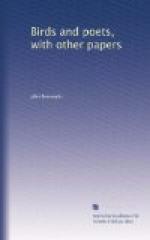All the descendants of Odin show a bovine trace, and cherish and cultivate the cow. In Norway she is a great feature. Professor Boyesen describes what he calls the saeter, the spring migration of the dairy and dairymaids, with all the appurtenances of butter and cheese making, from the valleys to the distant plains upon the mountains, where the grass keeps fresh and tender till fall. It is the great event of the year in all the rural districts. Nearly the whole family go with the cattle and remain with them. At evening the cows are summoned home with a long horn, called the loor, in the hands of the milkmaid. The whole herd comes winding down the mountain-side toward the saeter in obedience to the mellow blast.
What were those old Vikings but thick-hided bulls that delighted in nothing so much as goring each other? And has not the charge of beefiness been brought much nearer home to us than that? But about all the northern races there is something that is kindred to cattle in the best sense,—something in their art and literature that is essentially pastoral, sweet-breathed, continent, dispassionate, ruminating, wide-eyed, soft-voiced,—a charm of kine, the virtue of brutes.
The cow belongs more especially to the northern peoples, to the region of the good, green grass. She is the true grazing animal. That broad, smooth, always dewy nose of hers is just the suggestion of greensward. She caresses the grass; she sweeps off the ends of the leaves; she reaps it with the soft sickle of her tongue. She crops close, but she does not bruise or devour the turf like the horse. She is the sward’s best friend, and will make it thick and smooth as a carpet.
“The turfy mountains where live the nibbling sheep”
are not for her. Her muzzle is too blunt; then she does not bite as do the sheep; she has no upper teeth; she crops. But on the lower slopes, and margins, and rich bottoms, she is at home. Where the daisy and the buttercup and clover bloom, and where corn will grow, is her proper domain. The agriculture of no country can long thrive without her. Not only a large part of the real, but much of the potential, wealth of the land is wrapped up in her.
Then the cow has given us some good words and hints. How could we get along without the parable of the cow that gave a good pail of milk and then kicked it over? One could hardly keep house without it. Or the parable of the cream and the skimmed milk, or of the buttered bread? We know, too, through her aid, what the horns of the dilemma mean, and what comfort there is in the juicy cud of reverie.




